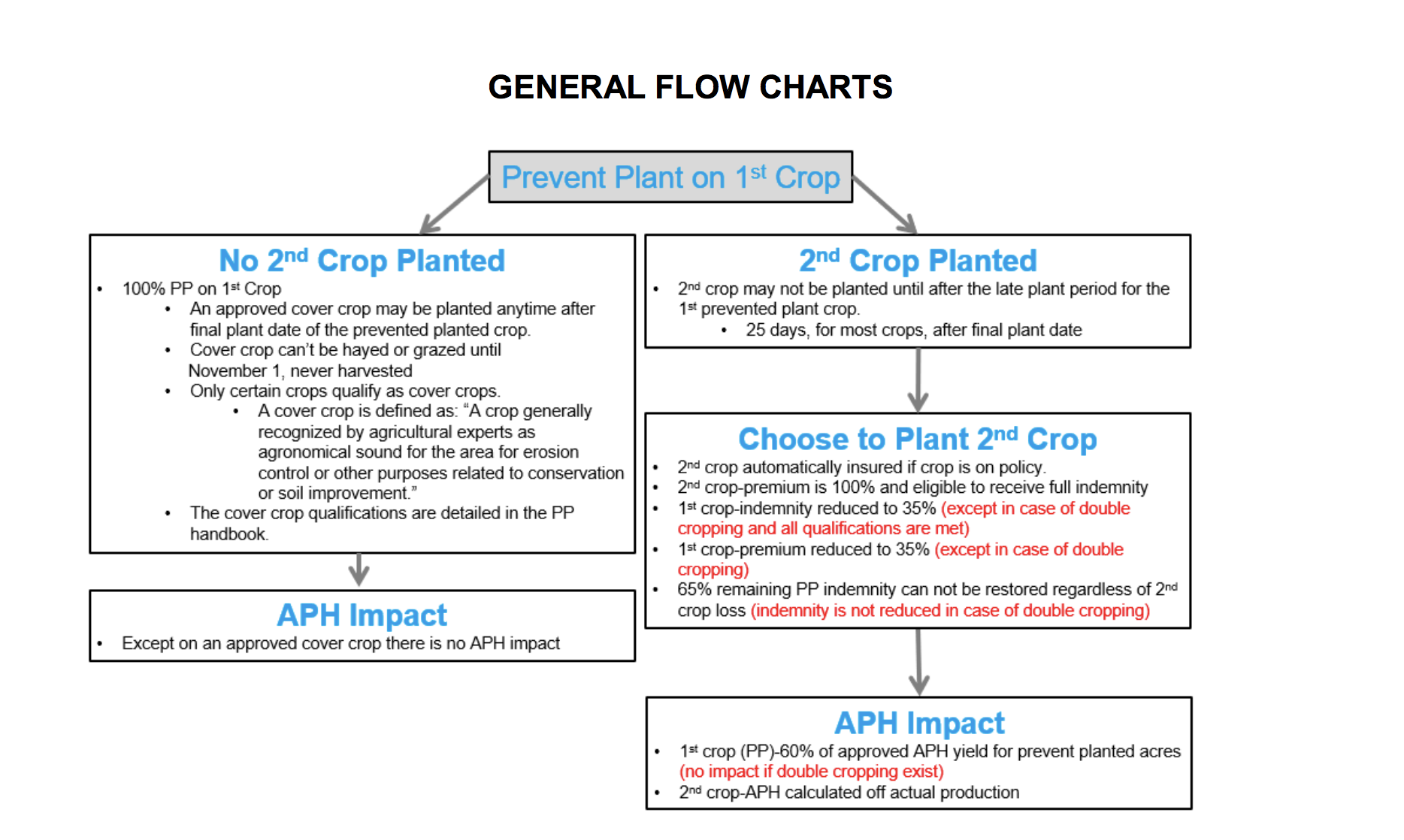To Qualify for Prevented Planting (PP) Payment
- Prevented planting must be due to an insured cause of loss that is general in the surrounding area and that prevents other producers from planting acreage with similar characteristics.
- The insured must have been prevented from planting the lesser of 20 acres or 20% of the unit. (If the crop is in a whole-farm unit, the 20 acre or 20 percent requirement will be applied separately to each crop in the whole-farm unit.)
- The insured must have eligible acres and ground must be available for planting.
- Total acres of planted and PP cannot exceed cropland acres. (Exception: DC acres)
- PP acres must be reported on the acreage report.
- PP claims must be filed no later than 72 hours after the final planting date or the end of the late plant period.
Prevented Planting Coverage is Not Available
- If a cause of loss has occurred that would prevent planting at the time ground is added to the operation.
- On ground where a pasture or forage crop is in place during the time planting of the insured crop generally occurs in the area.
- On ARPI policies.
- New breaking ground insured with a written agreement is not eligible for a PP claim.
- When other producers in the area were able to plant.
Determining Eligible Prevented Planting Acres
If the insured planted any crop in the county that had PP coverage available or received a PP guarantee in any one of the four most recent crop years:
- The eligible acres will consist of the maximum number of acres reported for insurance as certified for APH purposes in any of the four most recent crop years. (Not including PP acres planted to a second crop unless DC requirements are met.)
- Acres must have been planted in one of the last three crop years.
If, in any of the last four crop years, the insured has not planted any insurable crop for which there is PP coverage available (New Producer):
- The insured must submit a Prevented Planting Intended Acreage Reporting Form (RH-5066) by the sales closing date.
Exception: A producer may submit an intended acreage report within 10 days of obtaining acreage in a county if the producer did not have any acreage in the county on or before the sales closing date.
All planted acres (insurable and uninsurable) of the PP crop must be subtracted from the total determined eligible acres.
A PP payment may not exceed the amount payable for the crop that was prevented from being planted when the crop has no remaining PP eligible acres and another crop’s eligible PP acreage is used. If a crop with a higher PP payment is prevented from being planted, and the remaining eligible acres are for a crop with a lower PP payment, the additional acres claimed for PP for the crop with the higher PP payment would be paid based on the crop with the lower PP payment. This change protects program integrity by not allowing the PP payment to exceed the amount that would have been paid for the crop that was actually prevented from being planted. a. For example, if wheat is prevented from being planted and has a PP payment of $25, and there are no remaining eligible acres of wheat, the PP payment would be based on:
- If there are remaining soybean eligible acres with a PP payment of $35, the PP payment would continue to be based on wheat.
- If there were only remaining eligible acres for grain sorghum with a PP payment of $20, the PP payment would be based on grain sorghum.
Increasing Prevented Planting Acres
- The number of eligible acres may be increased by the percentage of increased cropland acres. To increase cropland acres, the insured must be prepared to provide current and previous years 578s and maps from FSA (or the adjuster may obtain same 1156 documentation from our internal systems).
- CRP ground coming back into production has PP coverage if released prior to any cause of loss that could cause a PP payment is evident. CRP ground coming back into production is considered added land for PP purposes.
- Previous year cropland 600 acres
- Current year cropland 700 acres
- Eligible Acres (200 corn and 300 soybeans) would be increased as follows:
- 700/600 = 1.167 increase factor
- 200 corn acres × 1.167 = 233.4 eligible acres
- 300 soybean acres × 1.167 = 350.1 eligible acres
